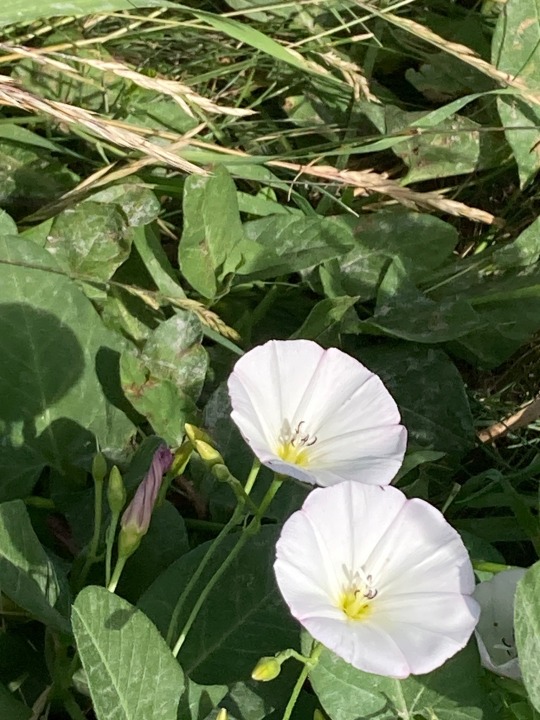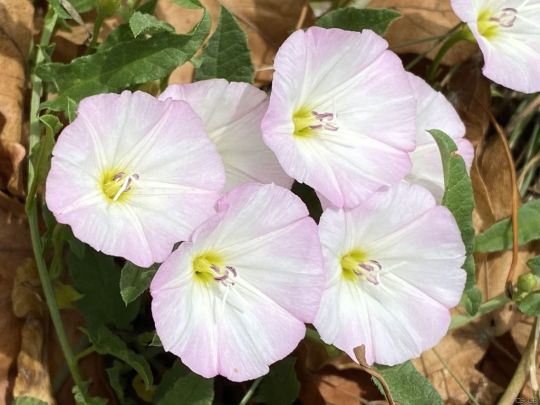#Convolvulus arvensis
Explore tagged Tumblr posts
Text


Field Bindweed is also known as Wild Morning-glory
#photography#nature photography#rocky mountains#colorado photography#original photographers#nature#flower photography#summer 2024#naturecore#artists on tumblr#flowers#fielf bindweed#morning glory#wild morning glory#Convolvulus arvensis#meadow#meadowcore#nevermind that this was a parkinglot grass area lol
21 notes
·
View notes
Note
I’d like to see Ryo if he was in the AU!
https://devilman.fandom.com/wiki/Satan_(Crybaby)



Name: Ryo Asuka
Series: Devilman Crybaby
Gender: Male
Status: Alive
Family: None As Of Now
Flower Motif: Field Bindweed (Convolvulus arvensis)
Flower Meaning: Manipulation
Weapon of Choice: Claymore
Associated With: Interdimensional Hero Club (Ally)
Hero Form Appearance: An outfit that combines a demon hunter with that of YuYuYu’s Hero Form outfits. The undersuit is a glossy jet black, which only makes the white stand out more, while the main outfit is a pearly white, with hints of light pink and light yellow about the outfit so it doesn’t get overwhelming. There are also accents of gold and silver to make them stand out a bit more, while the boots are a pearly white and knee high. The Field Bindweed’s petal shape can be seen in the tailcoat, short sleeves, and the gloves. What appears to be a wreath of the flowers serves as Ryo’s only accessory- apart from the vine wraps and necklace themed around the flowers.
Full Bloom Gauge Location: Right Elbow
Guardian: Furfur (Based on Furfur)
Favorite Food: Fettuccine Alfredo
Parallel To: None
Bio: A childhood friend of Akira, Ryo Asuka is a young prodigy who works as a college professor overseas. After discovering the existence of demons, he has enlisted Akira's aid in finding them and destroying them, lest they ravage the human race. But is there more to him than meets the eye?!
#shueisha#weekly shonen jump#crossover#wsj#yuyuyu#yuki yuna au#yuuki yuuna is a hero#yuuki yuuna wa yuusha de aru#yuyuyu au#character bio#flower#flowers#yuki yuna#yuki yuna is a hero#not shueisha#not shonen jump#Ryo Asuka#DevilMan#devilman crybaby#dmcb#dmcb ryo#field bindweed#Convolvulus arvensis
9 notes
·
View notes
Text





#Ackerwinde#Acker#Land#Convolvulus arvensis#Field#Landscape#Nature#Wild Life Nature#Wild Life Germany
10 notes
·
View notes
Text

Convolvulus arvensis / Field Bindweed on the Flatirons Vista Trail in Boulder, CO
#Convolvulus arvensis#Convolvulus#Convolvulaceae#Field Bindweed#Bindweed#Plants#Flowers#Vines#Nature photography#photography#photographers on tumblr#Flatirons Vista Trail#Flatirons#flatiron#Boulder#Boulder CO#boulder colorado#Colorado#🌺🌻
11 notes
·
View notes
Text

Convolvulus arvensis - field bindweed Anagallis arvensis - scarlet pimpernel
#mine#nature photography#original photography#herbology#convolvulus arvensis#anagallis arvensis#field bindweed#scarlet pimpernel#july 2023
5 notes
·
View notes
Text




7 notes
·
View notes
Text

Convolvulus arvensis
1K notes
·
View notes
Text

'Characters of Flowers' (1748-1759).
Abutilon, Convolvulus arvensis, Alsine and Iris, etching, coloured by hand, by Georg Dionysius Ehret.
© Victoria and Albert Museum, London, 2024.
49 notes
·
View notes
Text
Plants that grow in both Canada and Finland
* = not native to at least one of the two countries
Acer negundo (box elder)*
Achillea millefolium (common yarrow)
Alliaria petiolata (garlic mustard)*
Alopecurus aequalis (shortawn foxtail)
Anemone hepatica (common hepatica)
Arctagrostis latifolia (wideleaf polargrass)
Argentina anserina (common silverweed)
Artemisia vulgaris (common mugwort)*
Bellis perennis (lawn daisy)*
Berteroa incana (hoary alyssum)*
Betula pendula (silver birch)*
Bryum argenteum (silvery bryum)
Calamagrostis lapponica (Lappland reedgrass)
Calla palustris (marsh calla)
Campanula uniflora (arctic bellflower)
Cannabis sativa (cannabis)
Capsella bursa-pastoris (shepherd's-purse)
Carex adelostoma (circumpolar sedge)
Carex tenuiflora (sparse-flowered sedge)
Ceratodon purpureus (redshank)
Chamaenerion angustifolium (fireweed)
Chenopodium album (common lambsquarters)
Cirsium arvense (creeping thistle)*
Convallaria majalis (European lily of the valley)*
Convolvulus arvensis (field bindweed)*
Corallorhiza trifida (early coralroot)
Cornus suecica (dwarf cornel)
Crocus vernus (spring crocus)*
Cystopteris fragilis (fragile fern)
Datura stramonium (jimsonweed)*
Drosera rotundifolia (round-leaved sundew)
Dryopteris filix-mas (male fern)
Echium vulgare (viper's-bugloss)*
Empetrum nigrum (black crowberry)
Equisetum arvense (field horsetail)
Eriophorum scheuchzeri (Scheuchzer's cottongrass)
Festuca vivipara (viviparous sheep's-fescue)
Fragaria vesca (wild strawberry)
Galium trifidum (three-petal bedstraw)
Geranium pratense (meadow crane's-bill)*
Geranium robertianum (Herb Robert)
Geranium sylvaticum (wood cranesbill)*
Glechoma hederacea (ground-ivy)
Gymnocarpium dryopteris (northern oak fern)
Helianthus annuus (common sunflower)
Humulus lupulus (common hops)
Hyoscyamus niger (black henbane)
Impatiens glandulifera (Himalayan balsam)*
Juniperus communis (common juniper)
Lathyrus japonicus (seaside pea)
Leucanthemum vulgare (oxeye daisy)*
Lupinus polyphyllus (large-leaved lupin)*
Malus baccata (Siberian crabapple)*
Malus domestica (apple)*
Melilotus officinalis (yellow sweetclover)*
Monotropa hypopitys (pinesap)
Oxalis corniculata (creeping woodsorrel)*
Papaver somniferum (opium poppy)*
Petasites frigidus (Arctic sweet coltsfoot)
Phragmites australis (common reed)
Picea abies (Norway spruce)*
Pinus sylvestris (Scots pine)*
Poa arctica (Artic bluegrass)
Prunella vulgaris (common selfheal)
Pteridium aquilinum (common bracken)
Ranunculus lapponicus (Lapland buttercup)
Rosa acicularis (prickly wild rose)
Rubus idaeus (red raspberry)*
Salix lanata (woolly willow)
Saxifraga rivularis
Sceptridium multifidum (leathery grapefern)
Silene dioica (red campion)
Sonchus asper (prickly sowthistle)*
Sorbus aucuparia (European mountain ash)
Tanacetum vulgare (tansy)*
Taraxacum officinale (common dandelion)*
Trifolium pratense (red clover)*
Trifolium repens (white clover)*
Ulva intestinalis (gutweed)
Vaccinium myrtillus (European blueberry)
Vaccinium oxycoccos (bog cranberry)
Vaccinium uliginosum (bog bilberry)
Vaccinium vitis-idaea (lingonberry)
Veronica persica (bird's-eye speedwell)*
Veronica verna (spring speedwell)*
Viola palustris (marsh violet)
Viola tricolor (wild pansy)*
* = not native to at least one of the two countries
20 notes
·
View notes
Text

Convolvulus arvensis
#flowers#convulvulus#botany#plants#plant photography#bindweed#morning glory#creeper plant#hostel life#nature#garden
74 notes
·
View notes
Text

Convolvulus arvensis
39 notes
·
View notes
Text

02-16-24 Small Bindweed (convolvulus arvensis)
Cardstock, scrapbook paper, paper ephemera, book text and illustration from The Country Diary of an Edwardian Lady, acrylic paint, distress ink, watercolor, fabric, embroidery floss, chain from old earring, eyelet, stickers, washi tape
Background fabric by PeacoquetteDesigns on Spoonflower
#junk journal#junk journaling#art journal#art journaling#scrapbook#scrapbooking#collage#mixed media collage#mixed media#mixed media art#collage artist#paper collage
11 notes
·
View notes
Text
Plants for The Buried
Crab grass (Digitaria)
Wood sorrel (Oxalis)
Peppermint (Mentha × piperita)
Chickweed (Stellaria media)
Dandelion (Taraxacum officinale)
Canada Thistle (Cirsium arvense)
Bindweed (Convolvulus arvensis)
White Clover (Trifolium repens)
Nutsedge (Cyperus rotundus)
Japanese knotweed (Reynoutria japonica)
Lambsquarters (Chenopodium album)
Quackgrass (Elymus repens)
Curly dock (Rumex crispus)
Purslane (Portulaca oleracea)
Creeping charlie/Ground-ivy (Glechoma hederacea)
Broadleaf plantain (Plantago major)
Dove weed (Croton setiger)
Black medic (Medicago lupulina)
Spear thistle (Cirsium vulgar)
Ragweed (Ambrosia artemisiifolia)
Asiatic dayflower (Commelina communi)
Poison Sumac (Toxicodendron vernix)
Stinging Nettle (Urtica dioica)
Wild Madder (Galium mollugo)
#og.txt#popculture magic#paganism#pop culture paganism#tma paganism#tma pcp#the magnus archives#tma#the buried#the forever deep below
18 notes
·
View notes
Text

4 notes
·
View notes
Text

Convolvulus arvensis
10 notes
·
View notes



